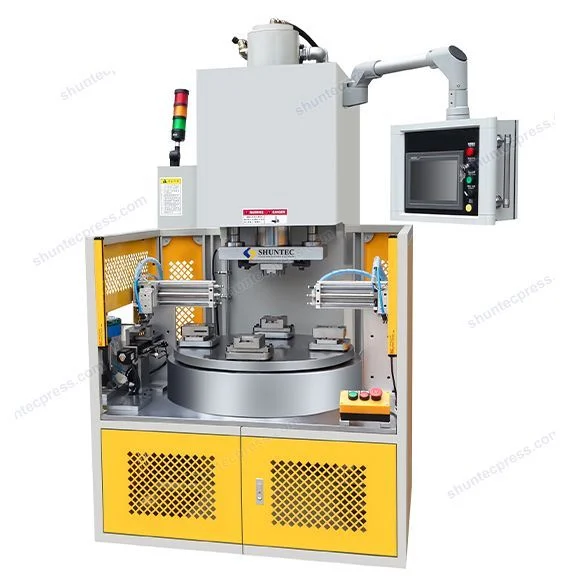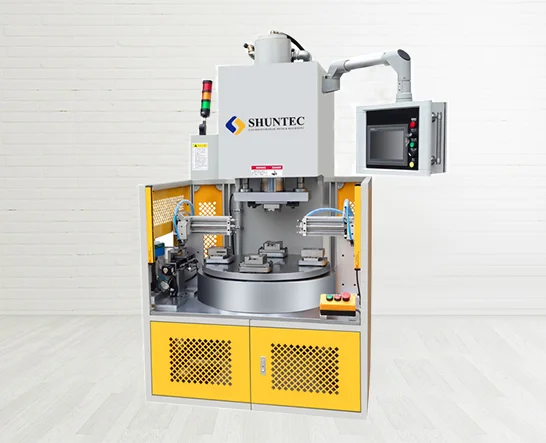1. Introduction to Assembly Presses
An assembly press is a versatile machine designed to apply controlled force to join, shape, or align components with precision. Commonly used in manufacturing, automotive, and aerospace industries, these machines streamline tasks like fitting bearings, pressing gears, or assembling electronic parts. Their ability to deliver consistent pressure ensures high-quality results, reducing errors compared to manual methods.
Assembly presses play a critical role in modern production lines. For instance, hydraulic assembly presses handle heavy-duty operations like forging metal parts, while pneumatic variants excel in high-speed, repetitive tasks such as electronics assembly. Custom assembly presses further cater to specialized needs, offering tailored solutions for unique material types or complex geometries.

Beyond industrial settings, these machines are vital in sectors requiring precision, such as medical device manufacturing or renewable energy systems. Advances in automation have also enhanced their efficiency, integrating sensors and programmable controls for smarter workflows.
Whether you’re working with delicate components or robust materials, understanding the basics of assembly presses helps in selecting the right equipment for your needs—a decision that directly impacts productivity, safety, and long-term cost savings.
2. Types of Assembly Presses
Assembly presses come in various designs, each tailored to specific tasks and industries. Understanding their differences ensures you select the right machine for your operational needs.
Hydraulic Assembly Presses
- How They Work: Use hydraulic cylinders to generate high, controlled force. Ideal for heavy-duty applications like forging metal parts or pressing large bearings.
- Key Advantage: Exceptional power and precision for demanding tasks.
Mechanical/Pneumatic Presses
- How They Work: Rely on mechanical linkages or compressed air for rapid, repetitive actions. Perfect for high-speed assembly of small components, such as electronics or automotive fasteners.
- Key Advantage: Speed and efficiency in mass production.
Custom Assembly Presses
- How They Work: Built to meet unique requirements, such as unusual part geometries or specialized materials.
- Key Advantage: Flexibility to adapt to niche industrial processes.
Industrial vs. Small-Scale Presses
- Industrial Presses: High-capacity machines for large-scale manufacturing (e.g., automotive frames).
- Small-Scale Presses: Compact units for workshops or prototyping, offering portability and ease of use.
Hydraulic models dominate heavy industries, while pneumatic systems thrive in precision-driven sectors. Custom solutions bridge gaps where standard presses fall short. By matching the press type to your workload, you optimize productivity and reduce operational costs.
3. Key Components and How Assembly Presses Work
Assembly presses rely on a combination of robust engineering and precise mechanics to deliver consistent results. Here’s a breakdown of their core components and operational workflow:
Core Components
- Frame: The sturdy base that supports the machine, often made of steel to withstand high pressure.
- Ram/Plunger: The moving part that applies force to the workpiece. Its speed and pressure are adjustable.
- Hydraulic/Pneumatic System: Generates power—hydraulic systems use fluid pressure, while pneumatic systems rely on compressed air.
- Control Panel: Houses buttons, levers, or digital interfaces to regulate force, speed, and cycle times.
- Die/Tooling: Custom attachments that shape or position components during pressing.
How They Operate
- Workpiece Placement: The component is positioned on the bed or within the die.
- Force Application: The ram descends, applying controlled pressure to assemble, shape, or compress the part.
- Pressure Holding: Maintains force for a set duration to ensure proper bonding or forming.
- Ram Retraction: The ram retracts, allowing safe removal of the finished workpiece.
Modern assembly presses often integrate automation, such as sensors to detect misalignments or programmable logic controllers (PLCs) for repeatable cycles. This reduces human error and boosts efficiency, especially in high-volume production.
By understanding these components and processes, operators can maximize machine performance while ensuring safety and precision.
4. Benefits of Using Assembly Presses
Assembly presses transform industrial workflows by combining precision, power, and reliability. One of their standout advantages is enhanced accuracy. Unlike manual methods, these machines apply consistent force every cycle, eliminating human error in tasks like bearing installation or gear alignment. This precision is critical in industries like aerospace, where even minor deviations can compromise safety.
Increased productivity is another key benefit. Hydraulic and pneumatic presses automate repetitive tasks, slashing assembly times while maintaining uniform quality. For example, automotive manufacturers rely on them to meet high-volume production targets without sacrificing part integrity.
Cost-efficiency also plays a major role. While initial investments vary, assembly presses reduce long-term expenses by minimizing material waste and rework. Custom presses further optimize costs by tailoring operations to specific materials or geometries, avoiding the need for multiple machines.
Safety improvements cannot be overlooked. Modern presses feature guards, emergency stops, and automated sensors, reducing workplace injuries associated with manual force application. Additionally, programmable controls allow operators to manage processes remotely, further lowering risks.
From speeding up production lines to ensuring flawless component integration, assembly presses deliver measurable ROI across industries like medical device manufacturing, renewable energy, and electronics. Their adaptability to both heavy-duty and delicate tasks makes them indispensable in today’s competitive manufacturing landscape.
5. How to Choose the Right Assembly Press
Selecting the ideal assembly press requires aligning machine capabilities with your operational demands. Here’s a structured approach to simplify your decision:
Key Factors to Consider
- Load Capacity: Match the press’s maximum force (in tons or kN) to your heaviest tasks—hydraulic presses excel for high-force needs.
- Workspace Size: Ensure the bed dimensions accommodate your largest components.
- Material Type: Hard metals may demand hydraulic systems, while softer materials work with pneumatic presses.
- Cycle Speed: High-volume production favors mechanical/pneumatic models for rapid cycles.
When to Opt for a Custom Assembly Press
Custom solutions shine in scenarios like:
- Unique part geometries needing specialized tooling.
- Hybrid processes requiring integration with robotics or sensors.
- Compliance with strict industry standards (e.g., medical or aerospace).
Comparing Brands and Features
- Durability: Prioritize heavy-duty frames and corrosion-resistant materials.
- Automation: Look for programmable controls (PLCs) or IoT-enabled systems.
- Safety: Features like emergency stops, light curtains, or overload protection.
- Support: Choose suppliers offering training, maintenance, and spare parts.
Final Tips
- Assess future scalability—can the press adapt to growing production needs?
- Request demonstrations using your specific materials or components.
- Balance upfront costs with long-term ROI, factoring in energy efficiency and downtime reduction.
By methodically evaluating these aspects, you’ll invest in a press that boosts efficiency, ensures safety, and aligns with your industry’s unique challenges.
6. Maintenance and Safety Best Practices
Proper maintenance and safety protocols are critical to extending the lifespan of assembly presses and ensuring operator well-being. Start with routine inspections of key components like hydraulic hoses, seals, and electrical connections. Look for leaks, cracks, or unusual noises during operation—early detection prevents costly breakdowns. Lubrication is equally vital; moving parts such as rams and guide rails require regular greasing to minimize friction and wear.
For hydraulic systems, monitor fluid levels and quality. Contaminated or degraded oil can impair performance and damage pumps. Replace filters as recommended by the manufacturer to maintain optimal pressure. In pneumatic models, drain moisture from air compressors to prevent corrosion.
Safety begins with operator training. Ensure all personnel understand machine controls, emergency stop procedures, and proper use of protective gear like gloves and safety glasses. Install physical safeguards such as light curtains or interlocks to prevent accidental activation during maintenance. Always lock out the power supply before servicing the press.
Finally, maintain detailed records of inspections, repairs, and replacements. This not only aids in troubleshooting but also ensures compliance with industry safety standards. By prioritizing proactive care and strict safety measures, businesses reduce downtime, avoid accidents, and maximize the reliability of their assembly presses.
7. FAQs
Assembly presses are vital tools in manufacturing, but their technical nature often raises questions. Here are answers to some of the most common queries:
What industries rely heavily on assembly presses?
Industries like automotive, aerospace, and electronics use assembly presses extensively. For example, automotive plants employ hydraulic presses for gear assembly, while electronics manufacturers use pneumatic models for delicate circuit board components.
Can assembly presses handle fragile parts?
Yes. Modern presses, especially servo-driven or pneumatic types, offer precise force control, making them suitable for fragile items like medical devices or microelectronics. Custom tooling further protects sensitive components during pressing.
How does a hydraulic tool assembly press differ from standard models?
Hydraulic tool presses are designed for high-force, heavy-duty tasks like forging or stamping. They use fluid pressure to generate immense power, whereas standard mechanical presses rely on flywheels or pneumatics for lighter, faster operations.
Are custom assembly presses cost-effective?
While custom solutions have higher upfront costs, they often save money long-term by optimizing workflows, reducing waste, and eliminating the need for multiple machines. They’re ideal for niche applications with unique part geometries or materials.
What safety features should I prioritize?
Look for emergency stop buttons, light curtains, and overload protection. Regular training on lockout/tagout procedures and proper tooling setup also minimizes risks.
How often should maintenance be performed?
Follow the manufacturer’s schedule, but generally, inspect hydraulic fluid monthly, lubricate moving parts weekly, and check electrical systems quarterly. Immediate attention to leaks or unusual noises prevents major failures.
8. Conclusion
Assembly presses are indispensable in modern manufacturing, offering unmatched precision, efficiency, and adaptability across industries—from automotive assembly lines to delicate medical device production. Their versatility, whether through hydraulic power for heavy forging or pneumatic systems for rapid electronics assembly, ensures they meet diverse operational demands.
Choosing the right press hinges on understanding your workload, material requirements, and long-term goals. Equally critical is adhering to maintenance routines and safety protocols, which safeguard both equipment longevity and operator well-being. By investing in quality machines, embracing automation, and prioritizing training, businesses unlock higher productivity and ROI.
As technology evolves, assembly presses will continue to drive innovation, enabling smarter, faster, and safer production processes. Whether upgrading existing systems or integrating custom solutions, staying informed about advancements ensures your operations remain competitive in an ever-changing industrial landscape.

